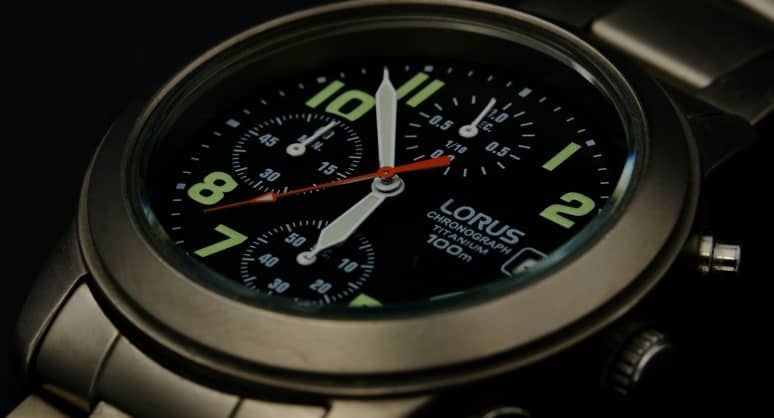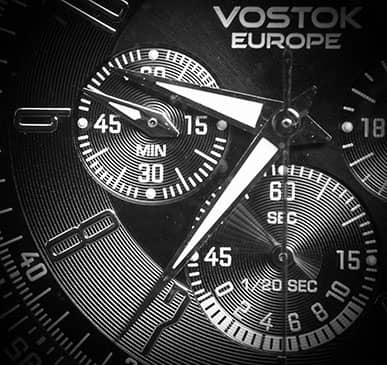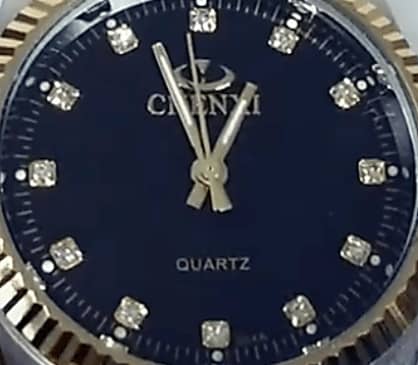Japanese watch brands are famous for their low cost compared to their Western counterparts, primarily due to their low production costs.
However, this does not mean that Japan does not manufacture precise and innovative timepieces. In fact, the Land of the Rising Sun has been the birthplace of some of the most important advancements in watchmaking.
Japan is the origin of inventions as significant as the quartz watch, which is more accurate and cheaper to manufacture than mechanical watches.
This revolution not only changed the way we measure time but also who could do it, as the mass production of low-cost watches made them accessible to a much larger audience.
| Crystal | Mineral |
| Movement | Japanese Quartz Casio Mod. 3159 |
| Materials | Resin case and strap |
| Case dimensions | 46 mm x 43.2 mm |
| Case thickness | 12.7 mm |
| Weight | 50 grams |
| Water resistance | 200 meters |
| Special features | Radio-controlled and solar-powered |
But the advancements in the Japanese watch industry didn’t stop there. They have continued to evolve and offer new improvements aimed at making our lives easier.
A good example is satellite technology, which allows a watch to automatically set itself to the correct time, or solar charging that provides nearly unlimited operation to watches.
Therefore, while Swiss watch brands have established their reputation through centuries of tradition and the luxurious aesthetics of their creations perfected over time, Japanese watch brands have focused more on the functionality and technology of their designs, aiming to make people’s lives easier.
In this article, we will delve into the history of the major Japanese watch brands and their significant creations, as well as other important brands in the Far East.
Índice de contenidos
✚ Best Japanese Watch Brands
➤ Seiko

Talking about the history of Japanese watches means talking about Seiko watches, one of the oldest watchmakers in Japan. In fact, with over 137 years of history, it can be said that the brand is not only one of the oldest in Japan but also in the rest of the world.
It was founded in 1881 by Kintaro Hattori in Ginza (Tokyo), and since then, it has transformed from a small watch shop to one of the most significant brands worldwide, mainly due to its continuous commitment to innovation and the development of new technologies that have revolutionized the market.
One of those advancements is precisely quartz movement, first equipped in the Seiko Astron in 1969, the first quartz wristwatch in history and the predecessor of many of the watches most of us wear today. This ingenious invention, powered by a battery, was up to 30 times more accurate than any mechanical watch of the time.
But Seiko has not limited itself to quartz watches. They also produce some of the most precise mechanical watches on the market, thanks to technologies like Spring Drive, which combines automatic movement with a quartz oscillator, achieving absolute precision without the need for batteries or accumulators.
Currently, the brand produces watches in all price ranges, from affordable digital timepieces to luxury pieces worth several thousand euros. Among the more affordable options are the Seiko Monster and Prospex diving watches, or the dressier Presage Cocktail series. In the high-end segment, there are watches like the Grand Seiko, one of the most precise watches in the world, or the Credor collection made with precious metals.
➤ Citizen

Founded in 1918, Citizen is the second oldest Japanese watch brand in Japan with its 100 years of history. Its origin lies in Tokyo, where it was originally established as the Shokosha Watch Research Institute.
The success of Citizen is primarily based on its wide range of watches, covering all price ranges. You can find anything from an elegant analog chronograph to a solar-powered tactical military watch or dive watches like the legendary Citizen NY0040.
But the brand is much more than just variety, as it has notable advancements such as the Citizen Eco Drive technology, one of the most advanced in the field of solar-powered watches.
It is so advanced that it can store energy for up to 1 year in some models, so your watch will always be ready to be used, even if you keep it stored in a drawer for long periods.
This represents a clear advantage over automatic watches, whose power reserve can last a maximum of about 50 hours in the best cases.
When we combine the Eco Drive technology with the hundreds of models the brand has manufactured, we have a wide range of watches with multiple functions that we can use as many times as we want without worrying about the battery running out.
They even produce solar radio-controlled watches, capable of automatically setting the time through signals received from different atomic clocks distributed around the world.
➤ Orient

Orient is the third-largest watch company in Japan in terms of production volume, surpassed only by Citizen and Seiko. It was founded in Tokyo in 1950, but its founder, Shogoro Yoshida, started the watch sales business in 1901 in Ueno, also in Japan.
As a curiosity, since 2009, Orient has been owned by Seiko and serves as one of its basic pillars, especially in the affordable automatic watch sector. It is worth noting that Seiko mainly focuses on quartz watches and only produces high-end automatic watches.
Although it is currently not an independent brand, Orient has made significant contributions to the global watchmaking industry in the past, such as the power reserve indicator, which displays a gauge on the dial showing the remaining winding of the watch.
The designs of this brand often feature more classic styles, with dress watches reminiscent of models from the 1950s, although they also have watches with more timeless designs, such as their diving series, Ray and Mako, which directly compete with Seiko Monster watches.
While most of their watches are in the mid-range category, they also offer luxury or semi-luxury models, such as the Orient Star series, with pieces that can cost several thousand euros.
➤ Casio

Arguably the most well-known of all, who hasn’t had a Casio on their wrist? What you may not know is that the company initially started manufacturing consumer electronics. In fact, Casio launched the world’s first electric calculator in 1957.
Founded in 1946 in Tokyo by Tadao Kashio, an engineer by profession, the company initially focused on producing printers, musical instruments, calculators, projectors, and other electrical devices.
However, it was in watches where Casio excelled, especially in the 1980s and 1990s, with iconic models like the Casio calculator watches and the Data Bank series, possibly the first smartwatches, even before the smartphone era.
Currently, one of their most popular models is the G-Shock, a watch whose structure can withstand almost anything, including shocks, falls, water, or dust. When combined with the numerous functions that the brand has always integrated into its creations, we have the perfect sports watch.
It is not uncommon to find a G-Shock with multiple sensors, for measuring altitude, pressure, or ambient temperature, all powered by solar energy. Some models are even radio-controlled and set themselves automatically. That’s why it’s not uncommon to see them on the wrists of soldiers in the US armed forces.
But Casio is much more than G-Shock and also offers elegant models made of steel or titanium, such as the Edifice series, robust analog designs that also incorporate a good amount of technological features, including Bluetooth or even GPS positioning in high-end models.
However, due to its electronic heritage, Casio only produces quartz watches. But who needs an automatic watch when you can have a practically indestructible solar-powered radio-controlled watch on your wrist?
➤ Pulsar and Lorus

The Lorus brand was created by Seiko Watch Corporation in 1982 to complement its Seiko collections. The goal was to create an affordable range of watches that still offered style, quality, and technology.
Pulsar is another brand under the Seiko Corporation, like Lorus, and both are similar in many aspects, but Pulsar has a longer history. In fact, Pulsar originally belonged to the Hamilton Watch Company.
Six years after being acquired by Seiko, the production of the brand was moved to Japan, and in 1972, Pulsar launched the world’s first digital LED watch.
While Pulsar is a brand that offers watches with a design similar to Lorus, many of its models use solar power and are water-resistant up to 10 bars, placing them at a higher level.
On the other hand, the Lorus brand is almost entirely composed of analog watches, while Pulsar also has some digital watches in its lineup, stemming from its LED watch heritage.
✚ All Japanese Watch Brands
In addition tothe well-known Japanese watch brands that we all know, the Land of the Rising Sun hides numerous brands that have not had the same worldwide impact as Seiko, Citizen, Orient, and Casio. However, some of them are starting to make their way into the US market.
Some of these brands are secondary brands of the more well-known ones. For example, Campanola belongs to Citizen, and Pulsar, responsible for the world’s first electronic watch, is currently a division of Seiko.
In any case, we should not confuse Japanese watches with Chinese watches, as many of the lesser-known brands mentioned here manufacture mid-range and high-end watches that can rival the most cutting-edge models in the European market in terms of features and price.
A
- Angel Clover
- Alive Athletics
C
- Campanola
- Casio
- Citizen
- Credor
F
- Furbo Design
- Frederique Constant
G
- GSX Time
I
- Issey Miyake
K
- Kentex
- Kikuchi Nakagawa
- Kiseki
- Kurono
- Knot
L
- La Mer Collections
- Lorus
M
- Minase
N
- Naoya Hida & Co.
O
- Orient
P
- Pulsar
S
- Seiko
- Spica
T
- Takeo Kikuchi
W
- Wired
4
- 4 Silent Birds
Related
Relojes.Wiki participates in the Amazon EU and Amazon US Associates Program, an affiliate advertising program designed to provide websites with a means to earn advertising fees by advertising and linking to Amazon.es, Amazon.com and Amazon.co.uk
As an Amazon Associate, I earn from qualifying purchases. More info.
Last update of links and images on 2025-12-28.


















